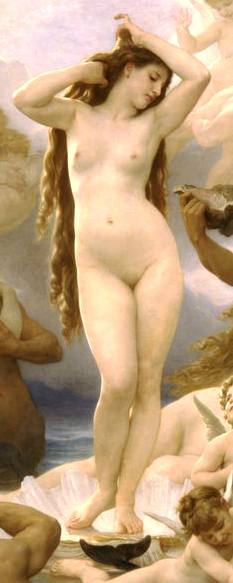|
LOVE
|
|||||||||||||||||||||||||||||||||||||||||||||||||
|
HOME | BIOLOGY | FILMS | GEOGRAPHY | HISTORY | INDEX | INVESTORS | MUSIC | NEWS | SOLAR BOATS | SPORT |
|||||||||||||||||||||||||||||||||||||||||||||||||
We all need love, to love and to be loved, but why. Love is nothing tangible, it is nothing you can bottle or sell, yet it is the most valuable thing to be possessed of on the planet earth and something we all search for.. That is not to say you could not survive without it - you could. But life would be incomplete. Without love, you may not reach highs you could otherwise reach, be inspired to do something special or create a masterpiece. It is love that drives us and makes us whole. So what is it and where can you find some? I'm afraid we can't help you find love. You might find that it finds you as you go about you business. One fine day you meet someone and bang - Cupid strikes again. As to a view of what it is or might be read on...............
The birth of Venus god of love
Love is a profound feeling of tender affection for or intense attraction to another. It is considered a deep, ineffable feeling shared in passionate or intimate interpersonal relationships. However, in different contexts, the word love has a variety of related but distinct meanings: in addition to romantic love, which is characterized by a mix of emotional and sexual desire, other forms include platonic love, religious love, familial love, and the more casual application of the term to anyone or anything that one considers strongly pleasurable, enjoyable, or desirable, including activities and foods. This diverse range of meanings in a single word is commonly contrasted with the plurality of Greek words for love, reflecting the word's versatility and complexity.
Although clearly and consistently defining love is a difficult task, and often a subject of much debate, different aspects of the word can be clarified by determining what isn't "love". As a general expression of positive sentiment (a stronger form of like), love is commonly contrasted with hate (or neutral apathy); as a less sexual and more "pure" form of romantic attachment, love is commonly contrasted with lust; and as an interpersonal relationship with romantic overtones, love is commonly contrasted with friendship, though other definitions of the word love may be applied to close friendships in certain contexts.
Overview
In ordinary use, love usually refers to interpersonal love, an experience felt by a person for another person. Love often involves caring for or identifying with a person or thing, including oneself (cf. narcissism).
The concept of love, however, is subject to debate. Some deny the existence of love. Others call it a recently invented abstraction, sometimes dating the "invention" to courtly Europe during or after the middle ages—though this is contradicted by the sizable body of ancient love poetry. Others maintain that love really exists, and is not an abstraction, but is undefinable, being a quantity which is spiritual or metaphysical in nature. Some psychologists maintain that love is the action of lending one's "boundary" or "self-esteem" to another. Others attempt to define love by applying the definition to everyday life.
Cultural differences make any universal definition of love difficult to establish. Expressions of love may include the love for a soul or mind, the love of laws and organizations, love for a body, love for nature, love of food, love of money, love for learning, love of power, love of fame, love for the respect of others, etc. Different people place varying degrees of importance on the kinds of love they receive. Love is essentially an abstract concept, easier to experience than to explain. Because of the complex and abstract nature of love, discourse on love is commonly reduced to a thought-terminating cliché, and there are a number of common proverbs regarding love, from Virgil's "Love conquers all" to The Beatles' "All you need is love". Bertrand Russell describes love as a condition of "absolute value", as opposed to relative value.
Traditional Chinese character for love (愛) consists of a heart (middle) inside of "accept", "feel", or "perceive", which shows a graceful emotion
Types of Love
Scientific views
Throughout history, predominantly, philosophy and religion have speculated the most into the phenomenon of love. In the last century, the science of psychology has written a great deal on the subject. Recently, however, the sciences of evolutionary psychology, evolutionary biology, anthropology, neuroscience, and biology have begun to take centre stage in discussion as to the nature and function of love.
Biological models of sex tend to see it as a mammalian drive, just like hunger or thirst. Psychology sees love as more of a social and cultural phenomenon. Psychologist Robert Sternberg created his Triangular theory of love and argued that love has three different components: Intimacy, Commitment, and Passion. Intimacy is a form where two people can share secrets and various details of their personal lives. Intimacy is usually shown in friendships and romantic love affairs. Commitment on the other hand is the expectation that the relationship is going to last forever. The last and most common form of love is simply sex, or passion. Passionate love is shown in infatuation as well as romantic love. This led researchers such as Yela to further refine the model by separating Passion into two independents components: Erotic Passion and Romantic Passion.
Chemical basis
Recent studies in neuroscience have indicated that a consistent number of chemicals are present in the brain when people testify to feeling love. These chemicals include; Testosterone, Oestrogen, Dopamine, Norepinephrine, Serotonin, Oxytocin, and Vasopressin. More specifically, higher levels of Testosterone and Oestrogen are present during the lustful phase of a relationship. Dopamine, Norepinephrine, and Seretonin are more commonly found during the attraction phase of a relationship. Oxytocin, and Vasopressin seemed to be more closely linked to long term bonding and relationships characterized by strong attachments.
In December 2005, Italian scientists at Pavia University found that a molecule known as the Nerve Growth Factor has high levels when people first fall in love, but these levels return to as they were after one year.
"NGF level was significantly higher (p<0.001) in the subjects in love [mean (SEM): 227 (14) pg/ml] than in either the subjects with a long-lasting relationship [123 (10) pg/ml] or the subjects with no relationship [149 (12) pg/ml]. Notably, there was also a significant positive correlation between levels of NGF and the intensity of romantic love as assessed with the passionate love scale (r=0.34; p=0.007). No differences in the concentrations of other NTs were detected. In 39 subjects in love who—after 12–24 months—maintained the same relationship but were no longer in the same mental state to which they had referred during the initial evaluation, plasma NGF levels decreased and became indistinguishable from those of the control groups."[1]
Cupid with bow and arrows
Cultural views
Although there exist numerous cross-cultural unified similarities as to the nature and definition of love, as in there being a thread of commitment, tenderness, and passion common to all human existence, there are differences. For example, in India, with arranged marriages commonplace, it is believed that love is not a necessary ingredient in the initial stages of marriage – it is something that can be created during the marriage; whereas in Western culture, by comparison, love is seen as a necessary prerequisite to marriage.
Religious views
Love in early religions was a mixture of ecstatic devotion and ritualised obligation to idealised natural forces (pagan polytheism). Later religions shifted emphasis towards single abstractly-oriented objects like God, law, church and state (formalised monotheism).
A third view, pantheism, recognises a state or truth distinct from (and often antagonistic to) the idea that there is a difference between the worshipping subject and the worshipped object. Love is reality, of which we, moving through time, imperfectly interpret ourselves as an isolated part.
The Bible speaks of love as a set of attitudes and actions that are far broader than the concept of love as an emotional attachment. Love is seen as a set of behaviours that humankind is encouraged to act out. One is encouraged not just to love one's partner, or even one's friends but also to love one's enemies.
The Bible describes this type of active love in 1 Corinthians 13:4-8:
Definitional issues
Dictionaries tend to define love as deep affection or fondness. In colloquial use, according to polled opinion, the most favoured definitions of love include the words:
Thomas Jay Oord defines love as acting intentionally, in sympathetic response to others (including God), to promote overall well-being. Oord means for his definition to be adequate for religion, philosophy, and the sciences.
MYTHOLOGY
EROS
In Greek mythology, Eros was the primordial god responsible for lust, love, and sex; he was also worshipped as a fertility deity. His name is the root of words such as erotic. His Roman equivalent was Cupid, "desire", also known as Amor, "love". He was often associated with Aphrodite. Like Dionysus, he was sometimes referred to as Eleutherios, "the liberator".
According to tradition, Eros was principally the patron of male love, while Aphrodite ruled mens' love of women. Thus his statue could be found in the palaestras, one of the principal venues for men to associate with their beloveds, and it was to him that the Spartans sacrificed before battle. Meleager records this role in a poem preserved in the Greek Anthology: "The Cyprian queen, a woman, hurls the fire that maddens men for females; but Erôs himself sways the love of males for males."
APHRODITE Aphrodite (Greek Ἀφροδίτη) is the Greek goddess of love and beauty and sexuality. Her Roman equivalent is the goddess Venus.
VENUS
Venus was a major Roman goddess principally associated with love and beauty, the rough equivalent of the Greek goddess Aphrodite. She was considered the ancestor of the Roman people by way of its legendary founder, Aeneas, and played a key role in many Roman religious festivals and myths.
Venus' cult began in Ardea and Lavinium, Latium. On August 18, 293 BC, her oldest-known temple was built, and August 18 became a festival called the Vinalia Rustica. On April 23, 215 BC, a temple was built outside the Colline gate on the Capitol dedicated to Venus to commemorate the Roman defeat at the Battle of Lake Trasimene.
Venus was commonly associated with the Greek goddess Aphrodite and the Etruscan deity Turan, borrowing aspects from each. Additionally, Venus has been compared to Tlahuizcalpantecuhtli in Aztec mythology, Kukulcan in Maya mythology, Frigg and Freya in the Norse mythos, and Ushas in Vedic religion. Ushas is also linked to Venus by a Sanskrit epithet ascribed to her, vanas- ("loveliness; longing, desire"), which is cognate to Venus, suggesting a Proto-Indo-European link via the reconstructed stem *wen- "to desire"[1].
REFERENCE and LINKS
SOME PROMINENT SOCIAL MISCARRIAGES OF JUSTICE:
Simon Hall | David Watkins | Katie Davis | Leon Benjamin Forde | Warren Blackwell | Darryl Gee
OTHER ANIMALS:
A taste for adventure capitalists
Solar Cola - the healthier cola alternative
|
|||||||||||||||||||||||||||||||||||||||||||||||||
|
This
website
is Copyright © 1999 & 2012 NJK.
The bird |
|||||||||||||||||||||||||||||||||||||||||||||||||
|
AUTOMOTIVE | BLUEPLANET | ELECTRIC CARS | ELECTRIC CYCLES | SOLAR CARS |


